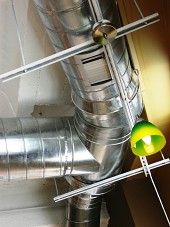Know Your HVAC System Components and How They Work
 An efficient HVAC system is important to the comfort of your family throughout the seasons of the year, because this climate control device is responsible for Heating, Ventilating, and Air Conditioning your home. Learn the facts about essential components of your HVAC system and find out the role each plays in keeping your household -- and its members -- warm in winter and cool in summer. That way, when something stops working you can either look into fixing it yourself, or let a HVAC company near you know exactly what the issue is so you can get your HVAC system back in working shape quickly.
An efficient HVAC system is important to the comfort of your family throughout the seasons of the year, because this climate control device is responsible for Heating, Ventilating, and Air Conditioning your home. Learn the facts about essential components of your HVAC system and find out the role each plays in keeping your household -- and its members -- warm in winter and cool in summer. That way, when something stops working you can either look into fixing it yourself, or let a HVAC company near you know exactly what the issue is so you can get your HVAC system back in working shape quickly.
1. Thermostat. The thermostat is usually the most visible part of your HVAC system. Set on a prominent, easily accessible wall, it may be either programmed in advance or set manually to keep the home at a desired temperature. When the ambient temperature becomes too cold or too hot, the thermostat will trigger the heat exchanger or the evaporator coil-condensing unit combo to begin circulating warmed or cooled air as needed.
2. Furnace. The furnace is the key component of your HVAC system. It's also the largest, requiring substantial space -- typically in the cellar, your finished basement, the attic, or a special closet designed for that purpose. Its function is to heat a supply of air which is to be distributed to various rooms of your home via the HVAC. This heating process is accomplished using one of four possible heat sources -- combustion (burning natural gas, oil, coal, or propane), electric resistance, heat pump, or solar energy collected on site.
3. Heat exchanger. The heat exchanger is found inside your furnace unit's housing. This component switches on when the furnace is activated by thermostat to produce warmer temperatures in winter. The heat exchanger pulls in cool air, heats it, and circulates the resulting heated air via your ducts and out through the vents.
4. Evaporator coil. The evaporator coil has an opposite role to the heat exchanger; it acts to cool the air when your thermostat is set to lower temperatures in summer. Located in a metal enclosure on the furnace's exterior, to the top or side, the evaporator coil works similarly to an automobile radiator to produce cool air, which is then circulated through the ductwork.
5. Condensing unit. The condensing unit is connected to the evaporator coil. This unit is installed by HVAC contractors on the outside of your home and filled with refrigerant gas. When the refrigerant has been cooled to a liquid by heat exchange with the exterior air, the condensing unit pumps the liquid to the evaporator coil to be evaporated into a gas once more.
6. Refrigerant lines. The refrigerant lines carry a refrigerant substance to the condensing unit vaporized in the form of a gas, and return it to the evaporator coil in liquid form. These "lines" are actually narrow tubes manufactured from a durable heat- and cold-resistant metal such as copper or aluminum.
7. Ductwork. Ductwork refers to the system of ducts that transports air warmed or cooled by the system to the various areas of your home. Ducts are commonly made of lightweight aluminum. However, they may also be manufactured from steel, flexible plastic, polyurethane, fiberglass, or fabric.
8. Vents. The vents are the rectangular outlets which transfer the heated or cooled air from the duct system into the individual rooms of your home. Made of high- and low-temperature safe metal, the vents are located on or near the ceiling and are usually fronted with angled slats ("vents"). These vents direct the treated air downward to where people are using the room. Often they may be manually controlled or even closed, to control the amount of heating or cooling and the area of the room to which it will be directed.
Hire a certified HVAC contractor for expert installation and repair.
Laura Firszt writes for networx.com.
Looking for a Pro? Call us (866) 441-6648

Heating & cooling Average Costs
HVAC Contractors Experiences

Gas Heater Repair To Prepare Our Garage For Winter

Fast Furnace Repair That Saved Me From Getting Ripped Off



